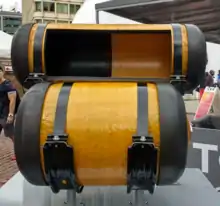Hydrogen tank
A Hydrogen tank (other names- cartridge or canister) is used for hydrogen storage.[1][2][3] The first type IV hydrogen tanks for compressed hydrogen at 700 bars (70 MPa; 10,000 psi) were demonstrated in 2001, the first fuel cell vehicles on the road with type IV tanks are the Toyota FCHV, Mercedes-Benz F-Cell and the GM HydroGen4.

Low-pressure tanks
Various applications have allowed the development of different H2 storage scenarios. Recently, the Hy-Can[4] consortium has introduced a small one liter, 10 bars (1.0 MPa; 150 psi) format. Horizon Fuel Cells is now selling a refillable 3 megapascals (30 bar; 440 psi) metal hydride form factor for consumer use called HydroStik.[5]
Type I
- Metal tank (steel/aluminum)...
Type II
- Metal tank (aluminum) with filament windings like glass fiber/aramid or carbon fiber around the metal cylinder.[6] See composite overwrapped pressure vessel.
- Approximate maximum pressure, aluminum/glass 263 bars (26.3 MPa; 3,810 psi), steel/carbon or aramide 299 bars (29.9 MPa; 4,340 psi).
Type III
- Tanks made from composite material, fiberglass/aramid or carbon fiber with a metal liner (aluminum or steel). See metal matrix composite.
- Approximate maximum pressure, aluminum/glass 305 bars (30.5 MPa; 4,420 psi), aluminum/aramide 438 bars (43.8 MPa; 6,350 psi), aluminium/ carbon 700 bars (70 MPa; 10,000 psi).
Type IV

- Composite tanks such of carbon fiber with a polymer liner (thermoplastic). See rotational molding and fibre-reinforced plastic.
- Approximate maximum pressure 700 bars (70 MPa; 10,000 psi).[7]
Type V
Tank testing and safety considerations
In accordance with ISO/TS 15869 (revised):
- Burst test: the pressure at which the tank bursts, typically more than 2× the working pressure.
- Proof pressure: the pressure at which the test will be executed, typically above the working pressure.
- Leak test or permeation test,[10] in NmL/hr/L (Normal liter of H2/time in hr/volume of the tank.
- Fatigue test, typically several thousand cycles of charging/emptying.
- Bonfire test where the tank is exposed to an open fire.
- Bullet test where live ammunition is fired at the tank.
This specification was replaced by ISO 13985:2006 and only applies to liquid hydrogen tanks.
Actual Standard EC 79/2009
Metal hydride storage tank
Magnesium hydride
Using magnesium[13] for hydrogen storage, a safe but weighty reversible storage technology. Typically the pressure requirement are limited to 10 bars (1.0 MPa; 150 psi). The charging process generates heat whereas the discharge process will require some heat to release the H2 contained in the storage material. To activate those type of hydrides, at the current state of development you need to reach approximately 300 °C (572 °F). [14] [15] [16]
Other hydrides
See also sodium aluminium hydride
Research
- 2008 - Japan, a clay-based film sandwiched between prepregs of CFRP.[17]
See also
References
- International hydrogen fuel and pressure vessel forum 2010 Archived 2012-09-05 at the Wayback Machine
- R&D of large stationary hydrogen/CNG/HCNG storage vessels
- CNG & Hydrogen tank safety, R&D, and testing
- Hycan Archived 2011-12-06 at the Wayback Machine
- Horizon HydroStik
- Onboard storage of hydrogen-Page 2 Archived 2006-11-27 at the Wayback Machine
- "Onboard type IV vessels" (PDF). Archived from the original (PDF) on 2007-11-10. Retrieved 2008-11-01.
- Modeling of dispersion following hydrogen permeation for safety engineering and risk assessment Archived 2011-07-23 at the Wayback Machine
- U.S. DOE storage safety
- U.S. DOE best safety practices hydrogen properties
- CNRS Institut Neel H2 Storage
- Dornheim, M.; Doppiu, S.; Barkhordarian, G.; Boesenberg, U.; Klassen, T.; Gutfleisch, O.; Bormann, R. (2007). "Hydrogen storage in magnesium-based hydrides and hydride composites". Scripta Materialia. Viewpoint set no. 42 “Nanoscale materials for hydrogen storage”. 56 (10): 841–846. doi:10.1016/j.scriptamat.2007.01.003. ISSN 1359-6462.
- Schlapbach, Louis; Züttel, Andreas (2001-11-15). "Hydrogen-storage materials for mobile applications" (PDF). Nature. 414 (6861): 353–358. doi:10.1038/35104634. ISSN 0028-0836. PMID 11713542.
- "Storage by Mc-Phy". Archived from the original on 2009-12-03. Retrieved 2009-11-29.
- Development of a Clay-Plastic Composite Material with Good Hydrogen Gas Barrier Property Archived 2008-08-21 at the Wayback Machine